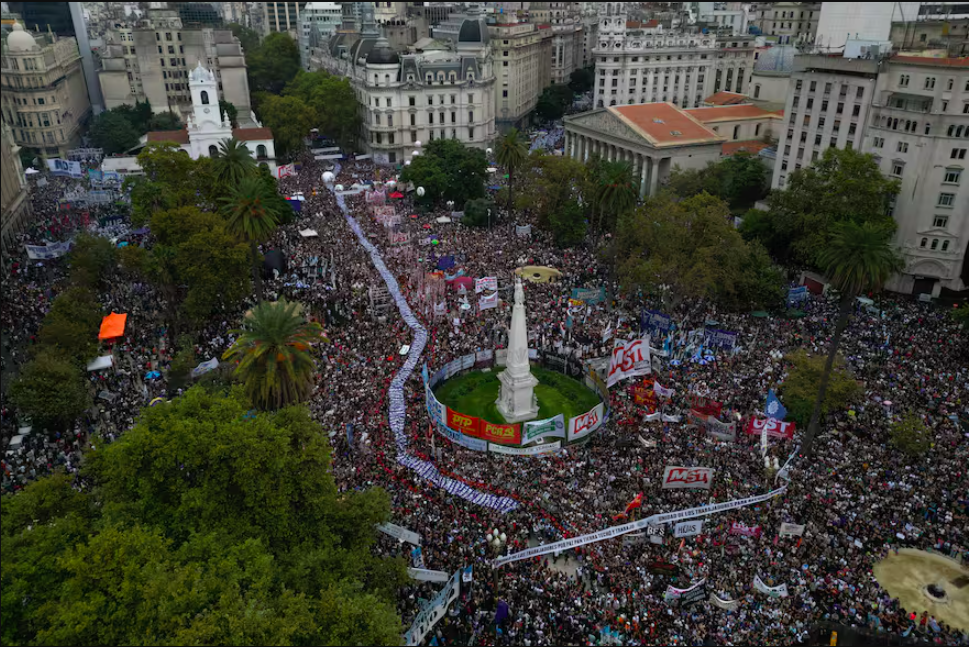
Published 24/03/2025 19:35 | Edited 25/03/2025 08:45
In March 24, 2025, a date that marks the 49th anniversary of the Argentine civil-military coup, a human tide occupied the Mayo Plaza and adjacent streets in response to the government of Javier Milei. With bands that displayed faces of missing and slogans like “Milei, garbage, you are the dictatorship”Protesters rejected the official question about the number of victims of the repression.
Called by human rights organizations, unions, political parties and social movements, participants in the traditional march for memory, truth and justice claimed the number of 30,000 missing during the military dictatorship and addressed strong criticism of the Javier Milei government.
Historical crowd and strong political presence
This year’s mobilization surpassed last year’s, the first under the ultraliberal government. The columns of protesters advanced through the North and South diagonals, reaching Julio 9 Avenue. The organizers estimated at 400,000 the number of participants.
Read too: Argentina performs his great march of memory, truth and justice against government Milei
Opposition political leaders attended by weight, including members of the government of the province of Buenos Aires, such as Axel Kicillof, Daniel Gollán and Victoria Oneto. Héctor Daer led the CGT column, accompanied by other union leaders. Groups such as La Carampora and the Milagro Sala Front were also present with bands and protest songs. The march brought from Kirchnerists to Trotskyists, reflecting the union forced by government repression.
Inflamed speech and complaints against the government
From the stage, mounted with his back to Casa Rosada, historical human rights leaders made emphatic speeches. Elia Esquen, from the founding line of the Mothers of Praça de May, Estela de Carlotto, president of the grandparents of May Square, and Adolfo Pérez Esquivel, Nobel Peace Prize, recalled the 1976 military coup and reaffirmed the consign: “We do not forget, we do not forgive and do not reconcile”.
“We do not reconcile with impunity,” said Carlotto, demanding answers about the whereabouts of the kidnapped grandchildren.
“No more house arrest to Genocidas!” Senteated, in reference to the elderly repressors who serve sentence at home.
Pérez Esquivel denounced “mass layoffs and attacks on retirees”, citing the case of Pablo Grillo, a photographer injured by tear gas in a recent protest.
The document read in the act denounced layoffs in the public and private sector, required retirement increases and charged justice to Pablo Grillo, a photographer injured during police repression in a previous march. Screams of “Bullrich Fora!” They echoed through the square, requiring the revocation of the Minister of Security Anti-Protocol.
Memory and resistance on the streets
The march was marked by symbols and honors to the victims of the dictatorship. Protesters carried tracks with photos and names of the missing, while songs by Los Piojos, Charly García and Patricio Rey y Sus Ricota played in the speakers. The traditional sentence “Mothers in the square, the people embrace you” It was accompanied by chants against Milei and Vice-President Victoria Villarruel, accused of relativizing dictatorship crimes.
The event also pressured the government for the declassification of secret files from SIDE (State Intelligence Secretariat) between 1974 and 1983. Milei Administration announced the release of these documents a few hours before the march, but protesters warned that this should serve to deepen investigations into missing and kidnapped babies in the dictatorship.
The measure, however, was seen as trained: Pablo Llonto (human rights lawyer) said that “Milei uses the same files he hid in 2024 to rewrite the story.” VERONICA TORRAS (Abierta Memory) considers that “Without transparency, it’s another negationist move.” Side, recreated by Milei in 2024, maintains direct connection with the intelligence structure of the dictatorship.
Although there was unity around the defense of memory, radicalized sectors of the Memoria Encuentro, Verdad y Justicia chose to publicize a document of their own, distancing themselves from Kirchnerist groups. Even so, their columns marched with bands they claimed: “Because there are 30,000, it was and is genocide”.
The continuity of the climate of protests will come with strike and elections. Union centrals promise to stop on April 10 against the Milei agreement with the IMF. Opposition tries to capitalize on discontent, but need to articulate a unified project to compete in vacancies in the National Congress.
With the dispersion began around 5:30 pm, it was evident that this year’s mobilization not only reaffirmed the struggle for memory and justice, but also served as a strong political message against the Milei government. The expectation now is about the possible reactions of the executive and new developments in Argentine politics.
Pérez Esquivel expressed the tone of the great march in the last words of his speech: “Today, Plaza showed that the dictatorship is not over. Malei is heir to Videla, but the people will not shut up.”
Source: vermelho.org.br

